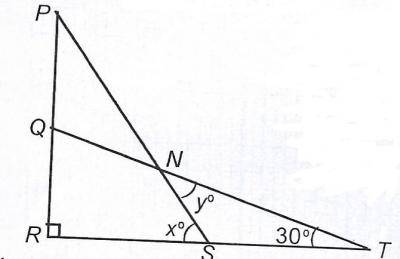5
4
3
2
Correct answer is D
Sn=n2(2a+(n−1)d
n2(2a+(n−1)d=n2+2n
n(2a+(n−1)d=2n2+4n
2an+n2d−nd=2n2+4n
Comparing the equations, d = 2 (coefficient of n2).
A function f is defined on R, the set of real numbers, by: f:x→x+3x−2,x≠2, find f−1.
f−1:x→2x+3x−1,x≠1
f−1:x→x+3x+2,x≠−2
f−1:x→x−12x+3,x≠−32
f−1:x→x−2x+3,x≠−3
Correct answer is A
f(x)=x+3x−2
f(y)=y+3y−2
Let f(y) = x,
x=y+3y−2
x(y−2)=y+3
xy−y=2x+3⟹y(x−1)=2x+3
y=2x+3x−1
Find the range of values of x for which 2x2+7x−15>0.
x<−32 or x>5
x<−5 or x>32
−32<x<5
−5<x<32
Correct answer is B
2x2+7x−15>0⟹2x2−3x+10x−15>0
x(2x−3)+5(2x−3)>0
(x+5)(2x−3)>0
For their product to be positive, they are either both +ve or -ve.
x+5>0⟹x>−5
2x−3>0⟹2x>3
x>32
Check:
x>−5:x=−3
2(−3)2+7(−3)−15=18−21−15=−18<0 (Not satisfied)
∴
x > \frac{3}{2}: x = 2
2(2^{2}) + 7(2) - 15 = 8 + 14 - 15 = 7 > 0 (Satisfied)
Simplify \frac{\sqrt{3} + \sqrt{48}}{\sqrt{6}}
3\sqrt{2}
5\sqrt{2}
\frac{5\sqrt{2}}{2}
\frac{3\sqrt{2}}{2}
Correct answer is C
\frac{\sqrt{3} + \sqrt{48}}{\sqrt{6}} = \frac{\sqrt{3} + 4\sqrt{3}}{\sqrt{6}}
\frac{5\sqrt{3}}{\sqrt{6} = \frac{5\sqrt{3} \times \sqrt{6}}{\sqrt{6} \times \sqrt{6}}
\frac{5\sqrt{18}{6} = \frac{15\sqrt{2}}{6}
= \frac{5\sqrt{2}}{2}
WAEC Subjects
Aptitude Tests
